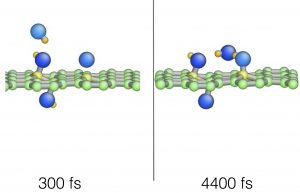|
Computational modeling of rupture mechanisms of graphene oxide
Graphene oxide (GO) is an important nanomaterial that has been used in various environmental applications due to its versatile chemical composition. Despite the great interest in GO and its properties, there is currently no consensus on its structural form and several models have been proposed. It has recently been proposed a model where the structure would consist of GO sheets and fragments physisorbed on the surface of these sheets (known as two-component model [1]). These fragments would be highly oxidized graphene pieces generated during GO purification processes. However, the presence of these fragments was explained by a mechanism proposed in 2015 that suggested that a disintegration of the GO [2], caused by a treatment with NaOH under heating, generates these fragments. In this project we intend to study this proposed mechanism using first principles calculations and molecular dynamics simulations in order to contribute to the elucidation of structural GO model. This work has the collaboration of Prof. Marcos D. Moreira (UFTM) and funding from FAPESP (Grant 16/01736-9) Related works: 1) Rourke, et al. “The real graphene oxide revealed: stripping the oxidative debris from the graphene like sheets“, Angewandte Chemie 2011. 2) Dimiev & Polson, “Contesting the Two-Component Structural Model of Graphene Oxide and Reexamining the Chemistry of Graphene Oxide in Basic Media“, Carbon 2015. 3) Moreira & Coluci, “Initial stages of graphene oxide cracking in basic media“, Carbon, 2019. |
|
Mechanical response of vertically aligned helical carbon nanotube forests
Related works: 1) Scheffer, Thevamaran, Coluci, Compressive response and deformation mechanisms of vertically aligned helical carbon nanotube forests, Appl. Phys. Lett., 2018. 2) Thevamaran, R.et al, C. Anomalous impact and strain responses in helical carbon nanotube foams, RSC Advances, 2015. 3) Coluci, et. al : Entanglement and the nonlinear elastic behavior of forests of coiled carbon nanotubes, Phys. Rev. Lett., 2008 4) V.C. Scheffer’s Dissertation work See news from UNICAMP Journal about this work (in Portuguese) here. |
|
Molecular dynamics simulations based on Green’s functions
Molecular dynamics (DM) is a computational technique used for the atomistic study of materials. Due to the rapid vibrational movement of atoms, the process of integrating the motion equations used in such techniques requires very small integration steps (~ 1fs), which limits the simulation of phenomena at realistic scales (~ ms). The Green’s function-based DM technique (GFMD) allows these integration steps to be extended, at least in studies involving harmonic harmonic approximation. However, this technique has a higher computational cost than the DM techniques usually used and still can not be used for phenomena involving temperature (ensemble NVT). We are developing an extension of GFMD to be able to simulate phenomena in the ensemble NVT. The goal of this project is to use high-performance computing techniques to accelerate GFMD in order to make it competitive with the techniques currently used. This work counts with the collaboration of Prof. Vinod Tewary of the National Institute of Standards and Technology and is part of the doctoral work of Fabio Andrijauskas. Related works: 1) Tewary, V. “Extending the time scale in molecular dynamics simulations: Propagation of ripples in graphene“, Phys. Rev. B. 2009. 2) Coluci, Dantas, Tewary, “Generalized Green’s function molecular dynamics for canonical ensemble simulations“, Phys. Rev. E 2018. |


 The response of forests of helical carbon nanotubes when subjected to mechanical compression is still not well understood. To study this response from the theoretical point of view, we have developed a mesoscale model that includes characteristics from both the individual tubes (e.g. helicity) and the whole forest (e.g. entanglement among tubes). Currently, we are interested in the role of the vertical orientation and distribution of the nanotubes along the height of the forests to the compressive response. This ongoing work has collaboration of
The response of forests of helical carbon nanotubes when subjected to mechanical compression is still not well understood. To study this response from the theoretical point of view, we have developed a mesoscale model that includes characteristics from both the individual tubes (e.g. helicity) and the whole forest (e.g. entanglement among tubes). Currently, we are interested in the role of the vertical orientation and distribution of the nanotubes along the height of the forests to the compressive response. This ongoing work has collaboration of 